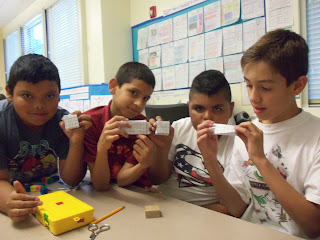 5.MD.C.5a Find the volume of a right rectangular prism with whole-number side lengths by packing it with unit cubes, and show that the volume is the same as would be found by multiplying the edge lengths, equivalently by multiplying the height by the area of the base.
5.MD.C.5a Find the volume of a right rectangular prism with whole-number side lengths by packing it with unit cubes, and show that the volume is the same as would be found by multiplying the edge lengths, equivalently by multiplying the height by the area of the base.5.MD.C.5c Recognize volume as additive. Find volumes of solid figures composed of two non-overlapping right rectangular prisms by adding the volumes of the non-overlapping parts, applying this technique to solve real world problems.

To begin this lesson, I gave each child a solid wooden block and showed them how to trace around it to form a rectangular prism net.
I showed them how to place the block at the top center of their graph paper and roll the block down the paper as they traced each of the four faces around the prism.
Next, they line the wooden block up again on one of the faces and tip the block on its end to trace one face on the left and another on the right of the four faces they have just finished tracing.
Make sure when they cut out the net that they do not cut on any of the fold lines.

The net should cut out as one piece. Then the children fold on each of the pencil lines.

If the students correctly followed all of the directions, it should form a prism that matches the solid wooden block.

Well done, Alejandra. :)

Before determining the volume, the children find the surface area. Here Cristal has written the square units and will then add them up to get a total of 112 square units for the entire net.

Angel and Ediverto are also having fun doing the activity with my class. Way to go, men!

After taping some of the edges of the prism, the students are ready to pack the net or package with cubes.

You may need to include a discussion about why we carefully pack the centimeter cubes inside in an orderly manner.
How does this help us add or multiply later?

Alejandra is trying to figure out how many cubes fit into her package without just counting each centimeter cube.
 Is there a way to use mathematics to help us find this easily?
Is there a way to use mathematics to help us find this easily?Patricio carefully emptied his package to determine how many centimeter cubes were in each layer and how many layers he had.

Fatima built only the bottom layer of cubes and then multiplied this times the number of layers in her package (multiplying by the height).

Leslie figured out the volume using numbers. She saw that there were 8 layers of 16 cubes for a total of 128 cubes.
I told the children that these were called cubic units.

Great photo, Esmeralda!!
Solving Problems with More Difficult Volumes

Such a great end-of-the-year activity...especially when our minds are focused more on summer vacation!!



















To begin this lesson, I gave each child a solid wooden block and showed them how to trace around it to form a rectangular prism net. Gui hang di My
ReplyDeleteYes, Kim. That also works well. You can see children using wooden block prisms in some of the photos above. But then Rigoberto and Esmerelda wanted more of a challenge so I brought in the snap cubes and let them experiment with how to make geo-jackets for more complicated shapes. Thanks for sharing!!
ReplyDelete